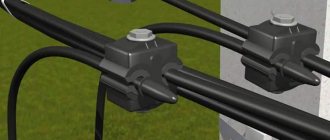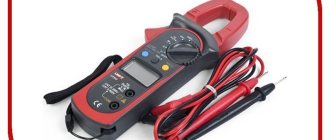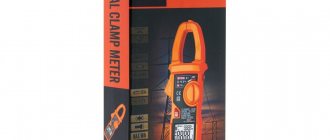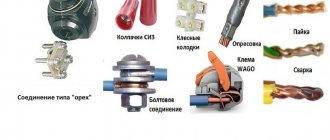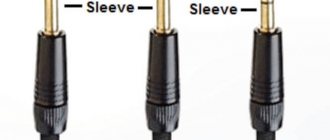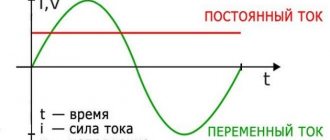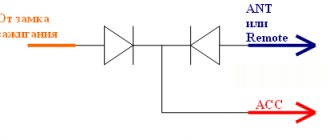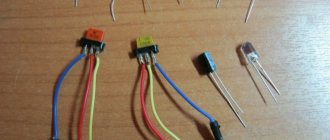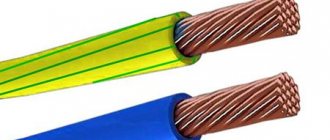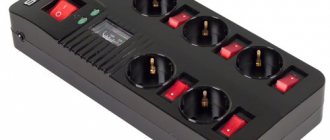This type of cable is increasingly used in industry and in everyday life. As the name suggests, a self-supporting insulated wire consists of several strands made of aluminum twisted together, but insulated from each other. In most cases, a steel core is located inside the cable, which is the load-bearing neutral core. SIP-4 branch wires, which do not have a supporting conductor, are also widely used. They are used to connect to overhead power lines and transmit current to transformers or other similar devices. Since the work is carried out on high voltage wires, special requirements arise for the connection of such cables. To ensure that the junction of the conductors is protected from damage and does not pose a danger to the environment, it is recommended to use branch clamps for SIP wires, which are installed using the puncture method.
Punctures for SIP
SIP laying
SIP is a single-phase or three-phase wire, the phases of which are insulated with durable polyethylene, resistant to ultraviolet radiation, and the neutral wire is the load-bearing wire.
This is an aluminum strand braided around a steel core. The neutral carrier wire can be insulated or not; three insulated phases are wound on top of it. Such a wire works in the distribution of electricity from transformer substations within the building boundaries, which, in general, justifies the increased concern for safety. These wires are insulated very well and hermetically, since external wiring is subject to all natural influences.
When laying SIPs, they are pulled from support to support, the two wires are joined to each other using a sealed clamp, which is crimped. Thus, the contact of the spliced wire and the insulation of the SIP cable along the entire line from beginning to end remains sealed.
To connect a branch line to the main line, specially designed self-piercing branch clamps are used. The technology in this case does not require removing the insulation from the wire; the clamp connects two wires using a puncture method, and the clamp itself creates reliable insulation of the branch from the outside.
The technology is as follows:
- Install the clamp onto the main insulated wire through the hole provided for this purpose and securely fix it.
- Pass the external connecting wire through the second hole.
- Using a wrench (usually 13 or 17), tighten the clamp head. The dosage of force for the cable is that when twisting, after piercing the insulation of both wires inside the clamp and creating reliable contact, the head breaks off, and the contacts inside the clamp are securely fixed.
- After the head comes off, the connection is reliable, and the insulation is solid and sealed.
- The end of the branch conductor is sealed with a special cap.
Connection of SIP with VVG cable
When introducing an electrical line into a structure, VVG cable or another similar brand of copper conductor is most often used. Direct contact of copper and aluminum conductors during installation is extremely undesirable. In this case, increased resistance to electric current occurs at the junction, which leads to overheating of the conductors, accelerated corrosion and destruction. Breaking the contact can lead to various negative consequences, including a fire. To prevent this from happening, special methods should be used to separate copper and aluminum conductors from each other.
The simplest of them is to connect a copper and aluminum core using a threaded connection. For this option you will need a steel bolt with a nut of suitable diameter, several simple washers and one engraving washer. Installation of such a connection is very simple: a washer is installed between dissimilar conductors to prevent direct contact of copper with aluminum. It is advisable to choose washers coated with pure tin or solder based on it. After tightening the bolt, the connection must be wrapped with insulating tape. This method is very simple, but extremely unreliable, so it is practically not used.
For a better and more reliable connection of SIP with copper cable, completely different methods are used, which are performed using specially designed connecting elements, such as piercing clamps, monolithic aluminum-copper sleeves and branching clamps. Let's consider each option separately.
- Piercing clamps. With this method, the insulation from the cores of the connected cables is not removed. A copper and aluminum conductor with an insulating layer is inserted into the corresponding hole in the clamp, after which the entire structure is tightened with a threaded connection. Tightening can be done either with one top bolt or with separate bots for each core of the connected cables. The body of the piercing clamp is made of durable polymer material with glass fiber reinforcement. It provides reliable protection to the connection from the effects of negative environmental factors.
- Branching compressions. Among experts they are called “nuts”. These connecting elements have in their design three bimetallic plates and tightening bolts, which are enclosed in a protective housing. To connect SIP to copper cable, you need to remove the insulation from the cores, insert it between the plates and secure with bolts. The use of clamps is more preferable for aluminum cores of self-supporting wires, since they are very sensitive to the notches that arise from the spikes of piercing clamps.
- Bimetallic sleeves. These connecting elements are made of copper and aluminum parts combined into one monolithic structure. The connection of dissimilar cores is carried out by crimping. The conductors are stripped and inserted into a sleeve, which is crimped with a special tool, thereby creating reliable contact. The connection point is sealed with a special heat-shrinkable tube filled with an insulating gel. Under the influence of high temperature, the tube contracts and reliably protects the contact from the negative influence of the external environment.
An alternative to all of the above methods of connecting self-supporting insulated wires with VVG copper cable or other brands is the direct insertion of self-supporting insulated wires into the building with a connection to the electrical panel. The rules of the PUE and the requirements of energy supply organizations do not prohibit this option, as it reduces the possibility of electricity theft.
Terminal markings
The markings of piercing clamps produced by different companies may differ from each other. It should contain information about the cross-sections of wires - main cable and branch. The defining parameters are the ranges of wire cross-sections.
For example, the marking, which has been in operation for more than 20 years, is as follows: ZPO 16-95/1.5-10, means: branch piercing clamp, main wire cross-section from 16 to 95 mm 2, branch wire cross-section from 1.5 to 10 mm 2 .
Here is an approximate range of piercing clamps from the company
- ZPO 16-95/1.5-10
- ZPO 16-95/4-35(50)
- ZPO 50-150/6-35(50)
- ZPO 50-150/50-150
- ZPK 35-95/4-54
Piercing clips in a rubber housing.
List of main characteristics
The characteristics of clamps of this type are determined by the following parameters:
- The number of branch SIPs that connect to the main core (usually from one to four).
- Cross-section of the main core (mm2).
- SIP cross-section (mm2).
- Maximum current load (A).
- Product weight (g).
As an example, we give a table of characteristics of NILED connecting fittings.
Characteristics of NILED connection clamps
Types of parts
The industry envisages the production of several types of clamps for SIPs. All of them are designed to work in certain conditions.
Branch piercing with one bolt
This type of clamp is also often called a bare clamp. It is used to lead the wire (uninsulated) to the vulture.
Distinctive features:
- Section from 16 to 95 mm.
- The polymer housing of the clamp can prevent UV rays from penetrating inside and is also resistant to various weather conditions.
- The branch clamp has a stable bar.
In this case, the branch piercing clamp is made of aluminum (alloy), which prevents rust
. Both the bolt and the mechanism are reliably made.
Piercing branch with two bolts
A tap component is used to route bare wires to the main trunk line to the sip line. The cross section can reach 95 square mm. The body uses highly resistant glass-reinforced polymer. For convenience, the branch clamp has a lower bar that helps fix the key in a given position.
This item will last a long time
, since it is resistant to moisture, wind and other manifestations of the external environment. Manufacturers, as a rule, are responsible for quality, so in this case you can count on it.
When choosing a clamp for SIP, it is worth remembering that the bolt head must be proportional to the key. most commonly used head is 13 mm
. Sometimes you can find 17 mm, but much less often. The size of the wire cross-section indicates the thickness of the line. From this size you can understand the size of the branch that should be mounted in the branch clamp. When choosing this part for SIP, you need to remember all these simple rules.
When designing electrical wiring, all issues that relate to running the cable to the input circuit breaker are often ignored, since this point is taken for granted. However, installing a piercing clamp for SIP wires is a very responsible undertaking that requires full mastery of the technology. When conducting wires, you must be guided by two bases - durability and safety.
In addition, it is important that any element or part of the chain can be reached without problems for the purpose of repair or replacement. In this article we will look at the principle of operation, purpose and installation features of a piercing clamp for SIP wires
Errors when connecting branch lines to the main line
- When installing the clamps, do not press the head completely. There may be a bad connection.
- Second time use branch clamps. Even if it looks like a working new one, during the first installation the cutting teeth may have been damaged (bent, broken), and contact in this case may not be possible.
- Connect wires that do not branch off from the main line, but are equivalent to each other.
- Try to use a clamp to connect not one, but two lines. Since the cutting contacts are centered along one core, they must accurately cut through the central part and enter the conductor. Otherwise they will miss or bend.
Attention
It is unacceptable to use branch clamps to connect wires inside the structure. In this case, the required level of tightness is not achieved, which can lead to moisture getting inside, and ultimately to an accident. A standard clamp for self-supporting insulated wire, depending on the manufacturer and application, can withstand voltages of 35,000 VAC and currents of up to 100 A.
Sources
- https://www.asutpp.ru/prokalyvajushhie-zazhimy-dlja-sip.html
- https://ProFazu.ru/provodka/montazh/prokalyvayushhij-zazhim-dlya-sip.html
- https://domikelectrica.ru/prokalyvayushhie-zazhimy-dlya-provoda-sip/
- https://amperof.ru/elektromontazh/electroprivodka/prokoly-dlya-sip.html
- https://onlineelektrik.ru/eprovodka/cabeli/prokoly-dlya-kabelya-sip-konstrukciya-i-pravila-ustanovki.html
Electricity supply via SIP
Electricity connection to a residential building is most often made using a self-supporting insulated SIP wire. It consists of several phase aluminum conductors covered with durable polyethylene insulation (cross-linked polyethylene) and a zero carrier. It can be with or without insulation. Often, for branches, a wire without a zero load-bearing core is used (SIP-4, SIP-5).
Compared to conventional cable, SIP has the following advantages:
- You can make the connection yourself. If the power line is de-energized, the connection process is completely safe. But if you don’t have the skills to work with electricity, it’s better to turn to electricians for help.
- Reliable power transmission in any climatic conditions. The wire can withstand high and low temperatures, gusts of wind and precipitation.
- Low price and durability.
SIP also has advantages over bare wires, which are also laid through the air:
- no porcelain insulators required;
- the distance between the cores decreases;
- there is no overlap of wires with each other under the influence of wind;
- Reactive losses are reduced due to the presence of insulation;
- Wire installation is simplified.
Branch from the main SIP line
A branch from the main SIP line, such as a branch from an overhead line or a linear branch, must be made in a certain sequence, which is described below.
- It is necessary to unwind the wire for the branch line.
- It is necessary to secure the wires at the very beginning of the branch line.
- It is necessary to tension the branch line and then secure its end.
- It is necessary to secure the branch line to specific supports.
- It is necessary to connect the branch line to the consumer.
- It is necessary to connect the SIP-2 branch or to the VLI.
The process of unwinding SIP for installing a branch line can be performed in the same way as the process of unwinding the main line. A distinctive feature may be the case when it is necessary to make a branch to connect a subscriber or consumer. In such a situation, the fittings used for branches may be slightly different and for such lines it is necessary to use a SIP system, which does not have a support wire and which consists of four or two insulated wires. Basically, the weight of such wires is significantly lower. Compared to main SIPs.
To secure the wires at the beginning of the branch line, you must use a special anchoring kit, which includes: a bracket and a clamp. To make a SIP-4 branch for connection to a house, you need to use some types of kits: EA 1000, EA 2000, EA 95-2000, EA 1500. Anchor clamps from the kits of this series can be attached to the bracket using a steel rope. Afterwards, you need to pull the neutral wire to the desired level and jam it using two wedges on the anchor clamp.
In order to correctly branch from the main line of self-supporting insulated wires that do not have a carrier wire, it will be enough to use during the work special clamps for subscriber wires, which are of the type HEL-5505, PA25x100. Just as in the version with the PA 1500 clamp, these clamps for subscriber wires are attached to the CA 1500 anchor brackets, which in turn must first be secured to the branch support. To do this you need to use a metal bow.
How to tension and secure the end of a branch line. These procedures are performed in exactly the same way with the highway. The only difference may be the case when you need to make a SIP-4 branch to connect to the house, when the end of the line is mounted on the facade or on the wall of the building. In such cases, it is possible to use a special wall bracket, the type of which is KNV. Its use will be advisable only in cases where the descent of the line deviates from the vertical by an angle of up to sixty degrees. If the angle is much larger, then it is better to use anchor brackets CA 1500. The brackets themselves can be attached to the building using dowels or screws, and then attach the clamp to it through a loop or bow.
How to secure the branch line to supports. If the project provides for intermediate supports, then in order to secure the SIP, the neutral of which is insulated, it is necessary to use intermediate clamps, which are of type ES 1500.
Connecting the branch line to consumers. In such work, a necessary condition will be the use of sealed tips covered with insulation. The first step is to lay the branch line wire to the connection point, then you need to accurately calculate how much wire is still needed. After this, you need to cut off the excess part of the wire using hand sector scissors. Tips can be used of two types: CPTA or CPTAU, it all depends on what material the consumer’s contact terminals are made of. To correctly select the size and type of tip, it is necessary to accurately determine the cross-section of the wire that is being mounted.
These are just some of the points you need to know in order to make a SIP-4 branch to connect to your home.
Advantages of branch compressors
In work, the use of such technology provides a number of undeniable advantages, in particular:
- Ability to work under voltage. Using the clamp, you can make a tap from the main SIP without de-energizing the line.
- The ability to connect wires made of different metals (copper and aluminum), provided that they are single-core.
- Tightening control - using a breaker head (in particular, in the P95 branch clamp it is aluminum) or using a dynamometer. In the first case, breaking the head means achieving the required pressure.
- Convenient removal method using a second screw.
- The case is hermetically sealed for the corresponding models. Leak tests are carried out in water using high voltage current.
- Compensation for temperature expansions.
- Speed of installation work.
- There is a wide range of wire gauges that can be connected this way.
Pros of use
Description of the benefits of using and installing such devices:
The consumer has the opportunity to work with a high voltage electrical network. By means of a clamp, a branch is made from the main self-supporting cable, without de-energizing the line. It is possible to connect conductors whose cores are made of various metals, for example, aluminum and copper
But it is important that these cables are single-core. Possibility of control of fixation thanks to the breaking head or using a dynamometer. In the first case, the element is made of aluminum
If the head breaks, this indicates that the tension has reached the desired level. The removal procedure is simplified by using a second bolt. Most modern models are equipped with a sealed housing. This parameter is checked by the manufacturer by applying high voltage to the product. Possibility of compensation of temperature expansions. Speed of installation work. A wide range of cable types that can be connected using this method.
The EKF channel spoke in more detail about the dangers associated with the use of this type of device.
OZPI
The technology of modern branch clamps with insulation piercing (IPPI) is developing in the following areas:
- improved contact system;
- new materials for the manufacture of clamp bodies;
- controlled tightening force of the main bolt;
- increased tightness of connections;
- increasing ease of installation.
Modernization of contact group
- Plates made of aluminum alloys and with pyramidal-shaped teeth, placed in a checkerboard pattern (Fig. a below).
- Aluminum or copper plates with wedge-shaped teeth like a saw (Fig. b).
- Aluminum plates that combine the advantages of previous types (Fig. c).
OPPI devices from popular manufacturers: a – Ensto; b – (1 – Sicame and Simale, 2 – Niled); c – Sicame and Simale
Any of the three methods guarantees the creation of a puncture of insulation and reliable electrical contact with the current-carrying core of the SIP. The material of the phase wires is softer than the neutral wire and the teeth penetrate deeper into them. In any case, the shear head of the tightening bolt ensures the creation of reliable electrical contact while maintaining the required strength of the conductor.
The housings shown in Fig. The above models are made of glass fiber reinforced polyamide. They have good mechanical and electrical properties and withstand weathering well.
The tightening process of the main bolt is controlled due to the shear head. It provides only one-time use of the OPPI. However, you can use a torque wrench to create the required force. This option was used in early models of devices, but it turned out to be not very convenient.
Using specific torque charts for different models, you can use a torque wrench for secondary installation. In this case, you cannot be completely sure of the reliability of the connections, since the piercing teeth in the clamp used are deformed.
Installers prefer models with minimal tightening force.
Installation sequence
To connect using GAM bimetallic sleeves you must:
- Remove the insulation from the SIP cable core and put on the coupling.
- Deform the retainer using a 6-sided mandrel, moving the tool along the sleeve and performing successive compressions.
- Strip the copper cable of insulation, insert it into the coupling and secure the cores with a hexagonal mandrel. The length of the exposed area depends on the dimensions of the sleeve.
- Place a shrink tube on the metal elements; to increase the tightness, you can use several protective covers.
If you plan to use clamps, then you need to bring the cable to the wall of the house and secure it with an anchor. Then a clamp is put on the wires (main and branches) and the bolt is tightened. It is necessary to follow the installation rules: with a weak force on the key, the contact pins do not penetrate well into the cable cores. Protective caps are placed on the exposed ends.
The main line entering the house is laid through a pipe that prevents melt or rain moisture from flowing into the shield.
Design
Structurally, the SIP clamp consists of:
- Waterproof or sealed housing (the latter is preferable).
- A kind of internal “terminal” made of one or more symmetrical plates with pyramid-shaped spikes, which are located in each of the sockets.
- A fastening system based on the use of a breakaway calibrated screw head.
- Additional clamp release system designed for emergency removal.
Inside the case there is a special lubricant that seals the puncture site, preventing water and air from coming into contact with the wire. This is also facilitated by the specific shape of the teeth.
The SIP clamp is tightened with an ordinary bolt with a 13, or less often 17, head. In total, the system has two bolts - one with a breakaway head, the other a regular one, which, if necessary, can be loosened to pull out the wire and disassemble the entire structure.
There are 2 or 4 sockets for wires. They can be of different diameters, for example, 16–120 and 6–50. Here the first group of numbers is the cross-section of the main wire, the second is the additionally connected one. One of the advantages of SIP clamps is that they (within certain limits) can be adjusted to fit cables of various calibers.
There are two main types of these connectors - with a breakaway head and with a torque wrench, which can be used to set the clamping force. In models with a breaking head, breaking occurs at a force of 9 to 20 Newtons (depending on the model). The same compression force must be achieved when using a modification with a torque wrench, since it is necessary that the teeth pierce the insulation and reliably enter the metal core. In this case, the teeth are significantly deformed - this, in combination with the breaking of the head of the clamping bolt, makes the clamp for SIP disposable. The fact is that, in order to combat the formation of oxides, the plate with spikes in the clamps is made of a relatively soft aluminum alloy. This is its difference from “piercing” terminal blocks.
There is no electrical contact between the connecting screws and the serrated plates. The housings are made from various polymer materials that are UV resistant and often have additional fiberglass reinforcement.
Description of the design features of special clamps
Branching a wire without stripping the insulation is done using special devices.
The clamps consist of the following elements:
- Sealed housing.
- Special plates for providing contacts.
- Aluminum piercing teeth.
- Disposable tightening bolts with twisted heads.
Piercing clamps are units placed in a housing made of fiberglass-reinforced polymer material. The housing has holes with contact plates for cable entry. The plates are equipped with teeth that serve to pierce the insulating material and ensure reliable contact with copper or aluminum conductors.
Insulation failure occurs due to the pressure of a special clamping bolt on the device. The cable is securely fixed in the device using a bolted connection with the original break-off head. This part secures the cable efficiently, protecting the contacts from squeezing and the threaded connection from breaking. The resulting connection is completely sealed.
Piercing clamps for electrical wires are used when laying overhead lines. Thanks to the tightness, the units are resistant to atmospheric influences. Changes in temperature and humidity do not affect the quality of the resulting compounds. Complete protection is ensured through the use of the supplied special rubber caps. The caps are designed to protect the exposed risers.
Manufacturers
Leading companies producing valves are Ensto, Niled and others.
Ensto
The Finnish company Ensto produces fittings for all types of SIP. Lightweight models are available, made of plastic, as well as those made of durable alloys for harsh working conditions. A feature of the piercing clamps produced by the company is the pyramidal design of the teeth, which increases the contact area and reduces the penetration of teeth into the wire, which reduces its damage. This contact part is similar in characteristics to clamps in the form of dies.
Niled
The French company Niled is the main supplier of fittings for SIPs in Russia. A characteristic feature of the products is adaptation to local conditions. Insulation piercing devices for domestic small-section wires have been developed for the Russian market. The range of supplies meets the technical requirements of RAO UES divisions.
Execution options
Piercing connecting fittings are produced in two versions, depending on the functional purpose. Let's talk briefly about each of them.
A device for connecting bare and insulated wires. The design (see Fig. 4) and operating principle were described above. The main purpose is to connect SIP to power conductors or the main grounding line.
Clamps for connecting SIPs to each other. The design feature of such devices is that the contacts on both eyes have teeth that pierce the insulation. Accordingly, two bolts are used for tightening. The operating principle of the clamp is the same as the previous version. The appearance of the device is shown below.
Piercing clamp for SIP-SIP connection
Classification of piercing clamps
Punctures for SIP come in two main types. The first is ZOI (insulated branch clamp). It is usually used to connect overhead lines with self-supporting wires at voltages up to 1000 V. Its operating principle is quite simple. The device is put on the desired wire and secured with a bolt, which is tightened until the head is torn off. This method of fastening allows you to ensure the required level of contact between the plates and the wire without damaging it. As a result, stable contact will arise between the main and the branch. If necessary, the clamp can be easily removed by unscrewing the lower bolt head, which is used for dismantling.
The second type is called ZOZRB IEK. It is used if it is necessary to organize a branch of two wires from an overhead line.
Note! This type of piercing clamps has certain limitations during operation. It should be installed in places where there is no high humidity to prevent water from getting inside
Therefore, it can only be used indoors.
The main difference between the second type of product is that it has piercing teeth only for installation on the main wire; the insulation will have to be removed from the branch conductor to ensure a reliable connection. At the same time, such a connecting mechanism allows you to use any type of conductor as a branch conductor, for example, VVG (unarmored vinyl insulated cable).
Connecting the cable to the overhead line using a clamp
Principle of operation
A piercing clamp for SIP is a special device that connects two parallel wires. It allows you to provide both parallel and serial connections - in the first case, with the help of a squeeze (as it is also called), a branch from the main wire is organized, in the second, a clamp is used to connect, inserting them into different (required!) sockets, two pieces of wire, and in their bare ends are covered with protective dielectric caps.
The electrical connection is made by piercing the outer insulation of a self-supporting wire with pyramid-shaped teeth, which, when pierced, reliably “seal” the place where they ate into the wire, preventing moisture from entering there.
Branch clamp for SIP wires price
Price for branch clamp for SIP
is an important factor when purchasing. We try to provide the most affordable prices for all products offered, which makes our offer one of the most profitable on the market. The price for a branch clamp is set according to the price list of the plant and the MRP established by the manufacturer. As a leader in the power transmission line equipment market, we are ready to offer the maximum discount on products from NILED and VK.
That is why it is carried out mainly with SIP cable (the correct name is self-supporting insulated wire), since it satisfies the owners in all respects. Its characteristics are a separate topic. But it is worth understanding in more detail the installation features and devices that are necessary for laying out the line (the so-called punctures for SIP cables), since their use has a number of nuances that are not typical when using other types of cables.
The power supply circuit for individual areas is often quite complex, since there may be several buildings on the territory that require connection to the industrial network. In order to make branches from the line, you need not only professional knowledge and skills, but also special reinforcement elements for various connections (couplings and the like).
But the main difficulty lies in cable cutting, connections, and reliable insulation of these sections. It is quite difficult to do all this with your own hands (and this is the most common installation option in the private sector). But when working with SIP, nothing like this is required. For this purpose, there are special branch clamps called punctures. Consequently, the process of assembling an on-site power supply circuit is greatly simplified.
How to choose the right one
There is a fairly wide variety of punctures for SIP cables. Most of them differ from each other in the diameter of the wires laid in them. Therefore, manufacturers offer both small-sized clamps with a diameter of connected cables from 6 to 95 mm², and standard ones - 35-150 mm².
It should be noted that clamps for SIP brand wires belong to the category of electrical installation fittings, which includes a fairly large list of various devices. There is a SIP tensioner, branch punctures, dies, various brackets, hooks (this is a fastening) and so on. All these elements are designed for the correct installation of self-supporting insulated wire by air.
Instructions for connecting the line to the trunk using a SIP clamp
Before you start work, you need to stock up on tools, safety equipment, have reliable access to the line where you are going to connect, and prepare it and the line to be connected.
Branch clamps are needed that correspond to the parameters of the lines. Wrench (usually 13). Latex gloves. To prepare the main line for connection, you need to find connection points for each phase.
The main line wire is disassembled into phase wires
Since SIP wires are usually wound onto a supporting neutral wire, they should be disassembled into individual phases very carefully, without using metal tools, so as not to damage the insulation. It is enough to free up a little space so that you can insert the clamp with the hole for the main wire
To release the phase wire, you must use a dielectric wedge.
Attention! When releasing the phase wires of the main wire from the twist, you must remember that the main wires are under high electrical voltage, which is life-threatening. Damage to their insulation is unacceptable! Under no circumstances should you push the phase wires apart with a screwdriver, pliers, or anything sharp or metal.
It is necessary to use a dielectric wedge. For greater safety, carry out work with rubber gloves and rubber galoshes.
Attention! Before connecting the branch line to the main line, which is energized, you need to prepare the branch line in advance. She must be:
- mounted, the end of the branch line must be fixed near the connection point so that the free ends of the line wires are sufficient to bring them to the terminals;
- the other end is brought to the wiring point;
- equipped with a disconnecting device (switch);
- in this case, the disconnecting device must be in the “Off” position. There should be a warning sign on it: “DO NOT turn it on, people are working!”
- Let's understand the wires of both lines. If they are multi-colored, then we connect them according to the colors. The most important thing is that the zero phase (blue wire) of the main line is connected to the zero phase of the outgoing line. If there is a ground wire (green-yellow), then it should also be connected to the “ground” wire of the branch. The colors of the phases may differ slightly from each other; the sequence is not so important here, although technical accuracy requires that they correspond to each other, at least approximately.
- Installing a piercing clamp for wires on the main wire of one of the phases. Since the main wire is without a break, a clamp is installed on it through the slot holes. The pre-tensioning bolt must be sufficiently loosened and the clamp must be suitable for the wire gauge range.
- The wire from the phase of the outlet cable corresponding to a given phase of the main cable is inserted with its end into the second hole of the clamp. The clamp must be loosened so much that when passing the wire into the hole, its insulation is not damaged by the sharp teeth of the contact plate (and at the same time the teeth do not bend, since in this case there will be no good contact).
- The head of the bolt of the piercing clamp for SIP is carefully tightened. In this case, both wires and the clamp are held in the normal position so that there are no distortions. We work with gloves!, since after some tightening efforts the insulation will be broken and the phase will flow into the outlet line.
- We continue to tighten until the head of the bolt falls off - this will be the required force so that compression occurs, the SIP is punctured and reliable contact is established.
Mistake #8 – Tightening with open-end wrenches
The shear nut must be tightened with spanners, not open-end wrenches.
Yes, of course, this can be done with carobs, but here the issue of skew again comes to the fore.
At the wrong moment, the key may break off and, due to the jerk, the puncture will become distorted, and the teeth, instead of deepening into the body of the insulation, will simply move to the side and become crushed.
The moment the bolt head comes off is not that small. On some clamps it is even indicated on the body (14 Nm - newton meter).
Which break head is better – metal or plastic?
Metal is still more reliable. This is explained by the smaller scatter of the stall moment.
This is especially true in winter, at subzero temperatures. The breaking torque of plastic will vary within a larger range from the factory parameters.
Accordingly, the contact will be of less quality.
Socket wrenches instead of open-end wrenches are also not always convenient. The breakaway nut often gets stuck inside the key.
The ideal option is spanners with a ratchet.
With them, the clamp does not twist the hand, and the applied force is transmitted perpendicular to the bolt, and not through an angle.
Some even rip off the head with a wrench.
But to do this, first of all you need to have such a tool at hand.
Manufacturers
In addition to our Russian manufacturers, foreign electrical companies produce and import electrical products to us.
Some of them: Enstio, Feman, Install, Niled, ETP.
Here, for example, is a branch clamp from ENSTO, article number SLIP 12.1.
The characteristics are as follows:
- Weight: 0.11kg
- Main line, mm²: 10–95 mm²
- Branch conductor, mm²: 1.5–50 mm²
- Conductor diameter: 3–16 mm
- Al/Cu 10-95 mm² with Al/Cu 1.5–50 mm²
SLIP12.1 The clamp is easy to install. Can be used to connect a live consumer. The hexagonal break head is isolated from the tightening bolt and the contact group of the clamp.
Can be used for 2x16 and 4x16 SIPs.
Types of punctures for SIP
ZOI
Branch insulated clamps are used when installing lines with voltages up to 1,000 V.
The technique for installing a puncture is well explained in the figure. Dismantling the clamp (if it is necessary to disconnect the branch line) is done quickly. It is enough to loosen the lower head, after which the device can be easily removed.
ZZZRB IEK
This modification of punctures is used when it is necessary to make 2 taps from one point on the line, using a different type of cable. Such clamps make punctures only on the network “thread”, and to attach a branch, its end will have to be cut, as usual.
In the private sector they are used less frequently, since the tightness of the contact point is not high enough. Consequently, when connecting SIP externally, such clamps have limitations in their use. The photo shows the internal structure of the IEK ZZRB puncture (without housing).
How to install correctly
As mentioned above, when this electrical installation is installed, there is no need to uninstall the cable itself. For example, you need to connect a branch to an existing line. How can such a connection of two wires be made (in fact, this will also be the fastening of the beginning of the outlet section)?
- The branch clamp is placed on the live line.
- The end of the wire for the branch section is inserted into the second groove.
- The bolt head is manually tightened until it stops.
- Then, using a spanner wrench, the bolt is tightened to such an extent that its head simply falls off. This indicates that the teeth of the device have reached the metal strands of the SIP wire.
The entire process is carried out only with dielectric gloves. Installation is quite simple, but it is not worth carrying out if you are not an electrician. There are certain restrictions and requirements regarding admission to this type of work. This is especially true for areas under voltage.
Design of cable piercings
- Frame. The specific operation of the puncture requires its increased strength and resistance to atmospheric factors. Therefore, reinforced polymers or duralumin are used for its manufacture.
- Connecting plates. The peculiarity of their design is in the teeth, which pierce the cable insulation, providing electrical contact.
- The bolts are tight. Depending on the modification of the puncture, 1 - 2 pieces. Heads are shear-type, that is, this fastener is intended for one-time use.
- Caps. Once installed in place, they completely cover the ends of the SIP, which may stick out from the outlet clamps. This ensures the tightness of the connections.
What are the benefits of using punctures?
The technology of installation work is simplified, since there is no need to cut the SIP cable. Reliable, sealed electrical contact. Possibility of connecting a branch to a line without removing voltage from it
It is important if you consider how much time, for example, a summer resident needs to spend to find a local electrician, and even to persuade him to turn off the power to the network.
Wedge characteristics
The use of plastic separating wedges will be more rational, since they:
- have comfortable grooved handles that prevent slipping during use;
- the material used in manufacturing is highly durable;
- sets of wedges are fastened with a rope, which prevents the possibility of the wedge falling out during use on the support;
- will not damage the insulation of the wires.
They are usually used during installation work on SIP conductors to separate the cores from the general bundle.
